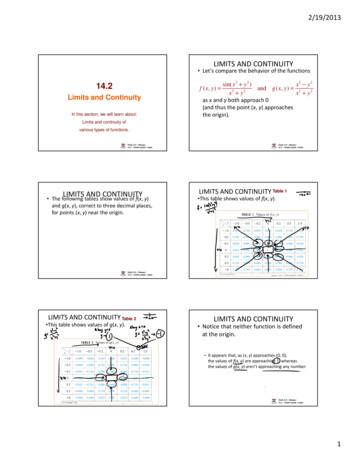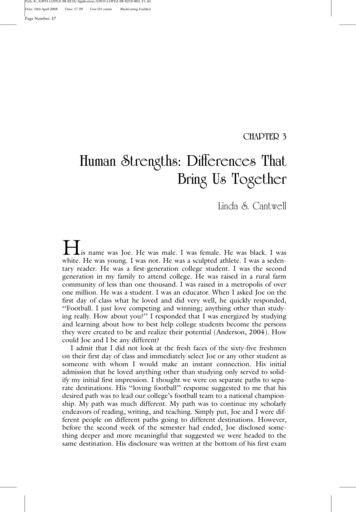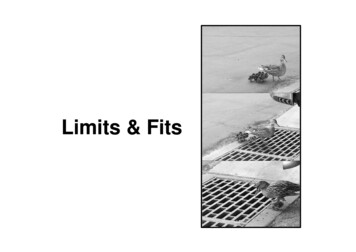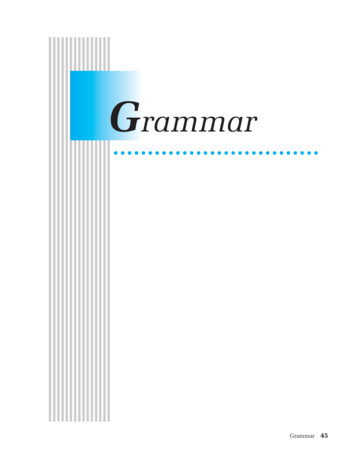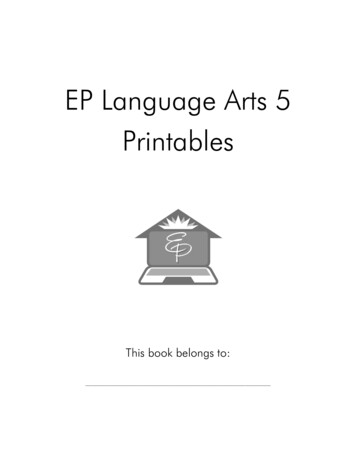
Transcription
Limits and Strengths of Predicate Logic(and its Alloy Implementation)Jan van Eijckjve@cwi.nlMaster SE, 22 September 2010
Some New BillboardsThere are some questionsthat can’t be answered by logicThere are some questionsthat can’t be answeredby computing machines
Automating First Order Relational Logic Relational logic First Order Logic plus Relational Operators. Most relational operations are expressible in first order logic, butnot all of them. Relation composition and relation transpose can be expressed infirst order logic: r.s can be expressed as {(x, y) zR(x, z) S(z, y)}. In Alloy:x- y in r.s iff some z x- z in r and z- y in s R can be expressed as {(x, y) R(y, x)}. In Alloy:x- y in r iff y- x in r
Beyond First Order Logic: Transitive Closure Transitive closure and reflexive transitive closure cannot be expressed in first order logic. The transitive closure of R is the smallest relation S for which:– R S,– S is transitive. To express r one would need an ‘infinite formula’:{(x, y) R(x, y) z(R(x, z) R(z, y)) z, v(R(x, z) R(z, v) R(v, y)) z, v, w(R(x, z) R(z, v) R(v, w) R(w, y)) ···}
Propositional Logic Propositional logic: logic of propositions. Example formulas:– p,– p q,– p p q,– p q ( p q). Why is propositional logic decidable and first order logic undecidable? Let us first see how first order logic is different from propositionallogic.
SAT The following questions about propositional formulas are equivalent:– F1 implies F2,– F1 F2 is true for every valuation.– F1 F2 is not satisfiable. The satisfiability problem for propositional logic is called SAT.
Decidability of Propositional Logic SAT is decidable Decision algorithm to check SAT of F :Any propositional formula mentions only a finite number of proposition letters. Say the proposition letters mentioned in F arep1 , . . . , p n .There are 2n possible valuations for these letters.Just work out the truth value of F for each valuation (using thetruth table method) to see if one of them is satisfiable.If this is the case, answer ‘yes’, otherwise answer ‘no’.
The Truth Table MethodFor instance, look at the formula p ((p q) (q p)).Suppose p has value 1 and q has value 0, then we get (using the truthtables): p has 0, p q has 0, q p has 0; (q p) has 1; (p q) (q p) has 0, the whole expression has 0.
p ((p q) . 1 . 1 . 0 .00.00 (q p)). 0 . . 1. 0.01In compressed form: p ((p q) (p p))0 1 0 1 0 0 0 1 0 0 0 1The method given above (the truth table method) can also be usedas a decision algorithm for propositional consequence.
Assignment for this week: implement propositional equivalence checking in Haskell. (Needed for automated testing of conversion routinesthat are supposed to preserve logical equivalence.)
First Order Logic Now look at the case of first order logic. A truth table method does not work here. Instead of valuations we need models. A model has a domain, and interpretations for all predicates andrelations. Look at x, y, z(Rxy Ryz Rxz) Alloy version:all x,y,z: Entity x- y in r and y- z in r implies x- z in rA model for this has a domain and a transitive relation on thatdomain. Let’s try this out in Alloy . . .
Alloy Examplemodule myexamples/rel tabstract sig Entity { r: set Entity }one sig A, B, C, D extends Entity {}fact r transitive {all x,y,z: Entity x- y in r and y- z in r implies x- z in r }pred show () {}run show
Formulas and Models Consider the above Alloy specification. The result of executing run show for this specification is a modelwith a transitive relation r on it. Think of the Alloy specification as a formula. Think of the picture that results from executing run show as amodel for that formula.
Another Way to Express Transitivitymodule myexamples/rel ttabstract sig Entity { r: set Entity }one sig A, B, C, D extends Entity {}fact r transitive {all x,y,z: Entity x- y in r and y- z in r implies x- z in r }assert r transitive’ { r.r in r }check r transitive’pred show () {}run show
Formulas with Only Infinite Models Consider the conjunction of:– x y(Rxy Ryx)– x yRxy(R is asymmetric)(R is serial)– x y z((Rxy Ryz) Rxz)(R is transitive). Suppose our domain is non-empty. Then every model of this conjunction is infinite. Why? The task of checking all relational structures (including infiniteones) in search for a model of a formula cannot be finished in afinite amount of time.
Consistency, Refutation of Consistency A first order formula is consistent if it has a model. The existence for formulas with only infinite models suggests thatfirst order consistency is not decidable. In fact, we have a semi-decision method: if a formula is inconsistent the method will determine this after finitely many steps. The method consists of constructing a so-called semantic tableau.This boils down to a systematic search for an inconsistency. There are consistent formulas for which the method loops. Therefutation method for consistency is not an algorithm. Note that nothing we have said above is a proof that a decisionmethod for first order consistency cannot exist.
Undecidable Queries The deep reason behind the undecidability of first order logic isthe fact that its expressive power is so great that it is possible tostate undecidable queries. One of the famous undecidable queries is the halting problem. Here is what a halting algorithm would look like:– Input: a specification of a computational procedure P , andan input I for that procedure– Output: an answer ‘halt’ if P halts when applied to I, and‘loop’ otherwise.
Undecidability of the Halting Problem Suppose there is an algorithm to solve the halting problem. Callthis H. Then H takes a computational procedure P as input, togetherwith an input I to that procedure, and decides. Note that H isitself a procedure; H takes two inputs, P and I. Let S be the procedure that is like H, except that it takes oneinput P , and then calls H(P, P ). Consider the following new procedure N for processing inputs P :If S(P ) says “halt”, then loop,and if S(P ) says “loop”, then print “halt” and terminate.
Undecidability of the Halting Problem (ctd) What does N do when applied to N itself? In other words, whatis the result of executing N (N )? Suppose N halts on input N . Then H should answer ‘halt’ whenH is applied to N with input N , for H is supposed to be a correcthalting algorithm. But then, by construction of the procedure, Nloops. Contradiction. Suppose N loops on input N . Then H should answer ‘loop’ whenH is applied to N with input N , for H is supposed to be a correcthalting algorithm. But then, by construction of the procedure, Nprints ‘halt’ and stops. Contradiction. We have a contradiction in both cases. Therefore a halting algorithm H cannot exist.
In Pictures . . .
Alan Turing’s InsightA language that allows the specification of ‘universal procedures’ suchas H, S and N cannot be decidable.But first order predicate logic is such a language . . .
Proof of Undecidability of First Order Logic The formal proof of the undecidability of first order logic consistsof– A very general definition of computational procedures.– A demonstration of the fact that such computational procedures can be expressed in first order logic.– A demonstration of the fact that the halting problem for computational procedures is undecidable (see the above sketch).– A formulation of the halting problem in first order logic. This formal proof was provided by Alan Turing in ?. The computational procedures he defined for this purpose were later calledTuring machines.
Turing Machines in Haskellmodule Turing wheredata State Q R S T U V Stopderiving (Eq,Show)data Symbol Zero One Blank deriving Eqinstance Show Symbol whereshow Zero "0"show One "1"show Blank "*"data Move Lft State Symbol Rght State Symbol Haltderiving (Eq,Show)
type Tape [Symbol]type Instr State - Symbol - Movetype Turing (Tape,Int,State,Instr)writeTape tape pos symbol take pos tape [symbol] drop (pos 1) tapestep :: Turing - Turingstep (tape,h,state,f) casef state (tape !! h) ofRght new symbol - (writeTape tape h symbol,h 1,new,f)
Lft new symbol - if h 0 then (writeTape tape h symbol,h-1,new,f)else (writeTape tape h symbol,h,new,f)Halt- (tape,h,Stop,f)compute :: Turing - [(Tape,Int,State)]compute (tape,h,Stop,f) []compute t@(tape,h,state,f) (tape,h,state) : (compute . step) trun :: Turing - IO()run turing sequence (map print (compute turing))
Example Machinesmodule TuringExamples whereimport Turingturing1 :: Turingturing1 ([Blank,Blank, Zero,One,Zero,One,Blank,Blank],0,Q,f)where f Q Blank Rght Q Blankf Q Zero Rght R Onef Q One Rght R Zerof R Blank Lft S Blankf R Zero Rght R Onef R One Rght R Zero
f S Zerof S Onef Lft S Zero Lft S One Haltturing2 :: Turingturing2 ([Blank,Zero,One,Zero,Zero,Blank],0,Q,f)where f Q Blank Rght Q Blankf Q Zero Rght Q Zerof Q One Rght R Onef R Zero Lft S Onef R One Rght R Onef S Blank Rght T Blankf S Zero Rght T Zerof S One Lft S Onef T Zero Rght Q Zerof T One Rght Q Zero
f Haltturing2’ :: Turingturing2’ ,f)where f Q Blank Rght Q Blankf Q Zero Rght Q Zerof Q One Rght R Onef R Zero Lft S Onef R One Rght R Onef S Blank Rght T Blankf S Zero Rght T Zerof S One Lft S Onef T Zero Rght Q Zerof T One Rght Q Zerof Halt
Example RunTuringExamples run ,*,*],2,S)([*,*,1,0,1,0,*,*],1,S)
Back to Alloy Alloy is not a decision method for first order logic Alloy translates first order logic with (small) finite scopes intopropositional logic. Consistency of these translations can be decided, for propositionallogic is decidable. SAT is intractable. More precisely, if one adds a single proposition letter, the computation time used by the truth table method doubles (for the truthtables become twice as big). This means that the truth table method is an exponential algorithm.
It is very likely that all other methods for solving SAT are exponential, for SAT is NP-hard.
Sat and P NP If we can solve SAT in polynomial time, we have solved the P NP problem. P NP is widely believed to be false, although nobody has beenable to give a proof of this. What this means it that we should not expect the Alloy methodto scale up. All future versions of Alloy will still only work for small domains. For a domain of size k, the result of adding an extra binary relation2R to the signature is that 2k possibilities for the interpretationof R have to be investigated.
Steps of the Alloy Analysis1. Conversion to negation normal form and skolemization.2. Translation (for a chosen scope) to a formula of propositional logic(a Boolean formula). Mapping between relational variables andBoolean variables is preserved.3. Conversion of Boolean formula to conjunctive normal form.4. CNF of Boolean formula fed to SAT solver.5. If SAT solver finds a model, a first order version of this is constructed using the mapping from 2.
Checking Relational Properties with Alloy Asymmetry of a relation: x y(Rxy Ryx). Irreflexivity of a relation: x Rxx. Every asymmetric relation is irreflexive.module myexamples/rel asymabstract sig Entity { r : set Entity }one sig A, B, C, D extends Entity {}fact r asymmetric { no r & r }assert r irreflexive { no iden & r }check r irreflexivepred show () { }run show
Checking Relational Properties (ctd)Do transitivity and symmetry together imply reflexivity?module myexamples/rel tsabstract sig Entity { r : set Entity }one sig A, B, C, D extends Entity {}fact r transitive { r.r in r }fact r symmetric { r in r }pred show () { }run showassert r reflexive { iden in r }check r reflexive
Checking Relational Properties (ctd)Do transitivity, symmetry and seriality together imply reflexivity?module myexamples/rel tssabstract sig Entity { r : set Entity }one sig A, B, C, D extends Entity {}fact r transitive { r.r in r }fact r symmetric { r in r }fact r serial{ all x: Entity some y: Entity x- y in r }pred show () { }run showassert r reflexive { iden in r }check r reflexive
Oops, Unexpected Alloy BehaviourWe get: counterexample found. Assertion is invalid.This is strange, for the assertion is valid. If we check inspect counterexample, then we see what is in fact a reflexive relation. Verystrange.
Debugging AlloyLet’s try a variation on the program:module myexamples/rel tssabstract sig Entity { r : set Entity }one sig A, B, C, D extends Entity {}predpredpredpredr trans { r.r in r }r symm { r in r }r serial { all x: Entity some y: Entity x- y in r }r refl { iden in r }TSSimpliesR: check {
r trans and r symm and r serial r refl}Again, we get a report of a counterexample.Again, if we inspect the ‘counterexample’, it turns out to be an example of a reflexive relation.
Debugging Alloy (ctd)Let us do a further check. Select ‘show’ and open the Evaluator.We get:Eval r{A 0- A 0, A 0- C 0, B 0- B 0, C 0- A 0, C 0- C 0,D 0- D 0}This is our example of a reflexive relation. Let us check the idenrelation:Eval iden{-8- -8, -7- -7, -6- -6, -5- -5, -4- -4, -3- -3,-2- -2, -1- -1, 0- 0, 1- 1, 2- 2, 3- 3, 4- 4,5- 5, 6- 6, 7- 7, A 0- A 0, B 0- B 0, C 0- C 0,
D 0- D 0}Oops, the identity is taken over a larger universe. Now it is no surprisethat iden in r fails:Eval iden - r{-8- -8, -7- -7, -6- -6, -5- -5, -4- -4, -3- -3,-2- -2, -1- -1, 0- 0, 1- 1, 2- 2, 3- 3, 4- 4,5- 5, 6- 6, 7- 7}
Debugging Alloy (end)OK, so the bug was in our definition of reflexivity. Now that we seethis we can solve the problem:module myexamples/rel tssabstract sig Entity { r : set Entity }one sig A, B, C, D extends Entity {}predpredpredpredpredr trans { r.r in r }r symm { r in r }r serial { all x: Entity some y: Entity x- y in r }r refl { iden in r }r refl’ { all x: Entity x - x in r }
TSSimpliesR: check {r trans and r symm and r serial r refl}TSSimpliesR’: check {r trans and r symm and r serial r refl’}
If There is Time: Induction and Recursion
Limits and Strengths of Predicate Logic (and its Alloy Implementation) Jan van Eijck jve@cwi.nl Master SE, 22 September 2010. Some New Billboards . f) where f Q Blank Rght Q Blank f Q Zero Rght Q Zero f Q One Rght R One f R Zero Lft S One

